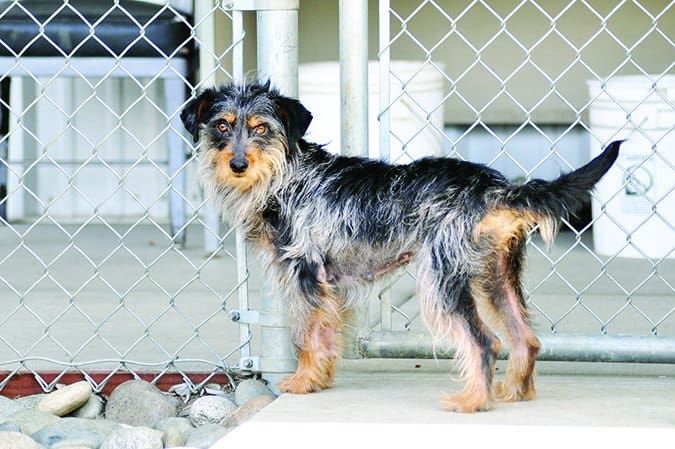[Updated August 24, 2018]
So – you’ve made your list of desired qualities and located a well-regarded shelter, rescue group, or breeder, and are ready to start your search. Perhaps you’ve already identified a prospect on an organization’s website. What now?
Go meet some dogs!
Here are six important observations to make for each dog you look at. Remember: take your time and don’t settle for a dog unsuitable to your lifestyle or needs.
1. Watch: If you can, stand back and watch your adoption prospect for a while.
Ideally, he comes forward and happily greets all visitors. Is he an equal opportunity greeter, happy to meet children and adults, men and women, people of different races, and people with odd mannerisms? If he’s in a foster home rather than a kennel, again, watch and note how he interacts with any humans present.
Concerns: If he happily greets some people but is troubled by others, he may need significant behavior work to help him accept those types of people. If he barks and lunges at passing humans or dogs, he could be generally reactive or aggressive, or it could just be barrier reactivity. This behavior may or may not continue when he is no longer kenneled. If it does, you will be doing significant behavior modification work.
If he moves to the back of the kennel and avoids contact with humans, he is likely fearful and/or undersocialized. You cannot fix fear with love alone. Dogs who are fearful will require a lot of management and behavior modification in order to be comfortable and safe (not a fear-based biting risk). Again, this may just be a response to the overwhelmingly stressful kennel environment, or it could be a bigger behavior issue. Some dogs behave like entirely different dogs when they are removed from their kennels and taken to a more normal environment, such as a get-acquainted room.

2. Engage: Assuming you are comfortable with his responses to others, approach the kennel.
Does he come up to greet you? When your other family members approach, does he stay engaged and friendly? Do you like what you see? If so, continue.
Concerns: He needs to respond well to all family members. A dog who is afraid of or reacts badly to one or more family member will likely be a source of conflict and is not a good choice.
3. Meet: Now it’s time to see him in a different, less-stressful environment.
Hopefully, the shelter or rescue has a quiet room or outside fenced area where you can spend get-acquainted time with the dog, away from the chaos of the kennels. Watch as the staff person or volunteer leashes him and removes him from the kennel. Does he avoid them and/or their touch? Do they have difficulty leashing him?
Concerns: Discomfort with or avoidance of close human contact can be an indication of lack of socialization or of abuse. This may require moderate to significant behavioral work.
4. Interact: Spend time with the dog, preferably in a separate room or fenced area.
Give him a little time to sniff and explore the room, without making an effort to engage him in any way at first. After he’s explored the room a bit, does he turn his attention to you and your other family members? Does he interact appropriately with you and other family members? Will he play with toys? Does he appear to have had any training? (Most dogs who have had some training will at least respond to a “Sit” cue.) Can he calm down and settle after you play with him, or does he stay aroused? Is he mouthy (putting his teeth on human skin)?
Think about how his behaviors will mesh with your family. Is he too energetic for your children? Does he pull too hard on the leash for them (or you!) to safely walk him? Are any of your family members afraid of him? Conversely, does he have no interest in you? Does he run away, or hide?
Concerns: The dog you adopt needs to be an integral member of your family. If you have children, the dog must adore small humans, and demonstrate this during your family’s interactions. “Tolerate” isn’t good enough. If he has behaviors that are wildly inappropriate, or that threaten the safety of family members, he will be a source of tension, and will likely end up shut away from the family a good part of the time, or perhaps returned to the adoption agency.
5. Ask: Shelter/rescue personnel may have additional information that they have not yet shared.
Was a behavior assessment done? (Remember to take assessment information with a grain of salt; see “Adoption Options,” below.) Is there an owner questionnaire that you could see? Behavior notes from staff and volunteers? Medical records? More information is always better.
6. Think and discuss: Assuming all has gone reasonably well so far, have a family discussion (or a mental discussion with yourself).
There are lots of dogs in need of homes. If this one isn’t a good fit, there will be one who is. Be willing to wait. On the other hand, if this is the right dog for you, full speed ahead! Get ready to comply with any additional adoption requirements the organization may have (fill out an application, landlord check, meet your current pets, etc.) and then be prepared for a lifetime of joy and fun with your new family member.

Adoption Options: Progress Isn’t Perfect
Adopting a dog hasn’t gotten any easier in the 40-plus years I’ve been involved professionally with animals. My two decades in animal sheltering (1976 to 1996) were prior to the emergence of the so-called no-kill movement. In those days, the art of doing behavior assessments for shelter dogs was just becoming the norm. We did our best to make available for adoption only those dogs who were likely to be successful companions and who could function reasonably well in society. We then trusted our adoption counselors to help make good matches, with a goal of placing every dog in a life-long, loving home where canine and human were well-suited to each other’s needs. We weren’t perfect, for sure, but we tried. Even then, finding the right dog was not an easy task for a prospective adopter.
Two significant changes have occurred in the past 20 years that can make it even harder. First, well-meaning, warmhearted “no-kill” animal lovers have made it their admirable mission to reduce the numbers of dogs and cats euthanized in shelters around the United States. Their efforts, alongside the ongoing spay/neuter and educational programs and hard work of shelters over the years, have not been fruitless; euthanasia numbers have dropped significantly. An estimated 18-20 million dogs and cats were euthanized in shelters in the 1980s; today’s estimate is two to three million. That’s great news, to be sure.
But there has also been an exponential proliferation of hoarders (individuals and rescue groups who take on far more animals than they can care for). Today, many dogs are “saved” from shelters – many of which are eager to improve their live-release numbers – only to be “rescued” by hoarders and forced to suffer from overcrowding, poor sanitation, disease, malnutrition, and death in the hands of their would-be saviors. Some supposedly no-kill shelters have, themselves, become institutional hoarders.
Plus, in the quest for better numbers, a significant percentage of non-hoarding adoption sources are placing poorly socialized dogs, dogs with other behavior problems, and even dogs with a known history of aggression. (A recent example: A rescue group in Virginia adopted a dog with a known history of aggression to a family that included a 90-year-old grandmother. The dog killed the grandmother on the first day in his new home.) Those who adopt from both hoarding and non-hoarding situations often find themselves facing significant health and/or behavioral challenges with their new canine companions.
To make matters worse, several recent studies suggest that shelter behavior assessments aren’t as useful as we have long believed them to be. The studies show that not only are there are a lot of “false positives” – dogs who show undesirable behavior in the assessment but not in a home environment, meaning they may be euthanized unnecessarily – but also, there are many “false negatives” – dogs who don’t show behaviors in the assessment that do show up later in the home, meaning adopters may be given false assurances about their new dogs’ behaviors. As a result, some organizations have discontinued any assessments, lowering or removing adoption screening standards, harking back to the unfortunate old days of “You want him? Plunk down your adoption fee
and he’s yours” – the standard practice when I started working in shelters.
ADOPTING A DOG: OVERVIEW
1. Give careful thought in advance to the qualities you and your family want in your new dog. Don’t allow yourselves to be swayed by an adorable face if the dog behind the face doesn’t meet at least most of your desired criteria.
2. Take your time. There are lots of dogs looking for their forever families. You might as well hold out for one who will do well in your home.
3. Consider utilizing the services of a training/behavior professional if you are not confident in your ability to make a good choice. Many trainers are aware of dogs, perhaps belonging to former clients, who need new homes for any number of sad reasons (divorce, illness, financial difficulties, etc.).
Author Pat Miller, CBCC-KA, CPDT-KA, of Fairplay, Maryland, is WDJ‘s Training Editor. Miller is also the author of many books on positive training. Her newest is, Beware of the Dog: Positive Solutions for Aggressive Behavior in Dogs.






